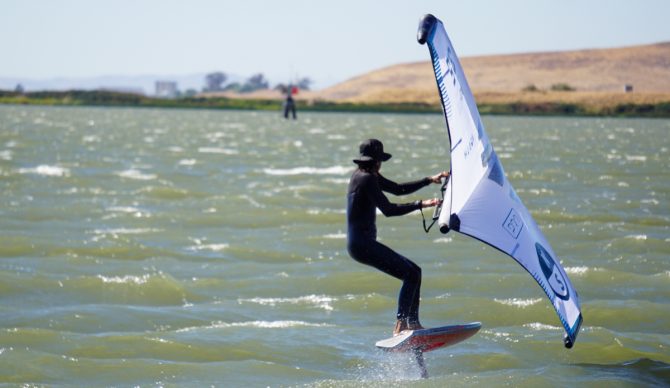
We’ve done our testing, and the results are in. These are the best wings for wing foiling in 2025. Photo: Ken Cox//The Inertia
Wing Foiling has been described as the fastest-growing watersport in the world, and while we’re not here to confirm or deny such a claim, we can certainly understand why it would be. All you need is a body of water and some wind. No more struggling with the weight and bulk of a windsurfer setup, or the power and required launching area of a kite. The wing and foil setup is fairly compact and highly versatile, capable of launching nearly anywhere and, with the right equipment, in wind speeds of 10 knots or less. Side-note to the uninitiated – that’s hardly more than a breeze.
Following is our second-edition review of the best wings in the wind industry that’s been a constant testing project over the past three years. The red-hot wing market is literally changing weekly with new innovations and products constantly hitting the market. So we certainly plan on keeping this review updated.
Below, we call out some favorite wings for specific applications. However, take note of the fact that all the wings included in this review are top-tier wings that rose above the competition, and the race for the “best of the best” was often tight and nitpicky. In other words, there’s not much of a gap between the first-listed item on this review and the last – they’re all on this list for a reason and would be an incredible choice for your wing-borne pursuits.
Jump To: All-Around Wings | High Performance Wings | Surf Wings | Light Wind Wings | Comparison Table | How We Tested | Buyer’s Guide
Related: Best Wing Foil Boards | The Best Foils | More Foil Gear Reviews
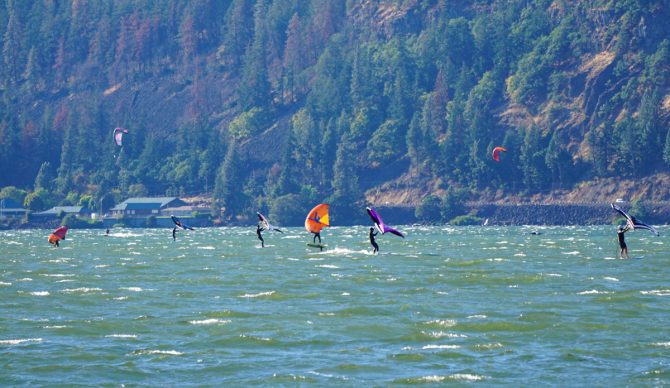
Wingers enjoy the perfect conditions in Hood River. Photo: Ken Cox//The Inertia
The Best Wings for Wing Foiling of 2025
All-Around Wings
Versatile and Powerful: Duotone Unit 2026
Does Everything Well: Reedin Supernatural 2025
User-Friendly: Slingshot Slingwing V6
Great for Intermediate Riders: Cabrinha Mantis V5
Interchangeable Handles: North Nova Pro
High Performance Wings
All-Around Shape with a High Performance Bent: Armstrong XPS MkII
Super Stiff, Direct Control: F-One Strike V5
Speedy and Surfy: Ozone Flux V2
Aluula Performance: CORE Halo Pro
Strong and Durable: North Mode Pro
Surf Wings
Stiff and Lightweight: F-One Swing V5
Incredible Luffed Performance: Duotone Float
Light Wind Wings
Traditional and Aluula Options: Duotone Ventis
Semi-Aluula Construction: F-One Strike CWC
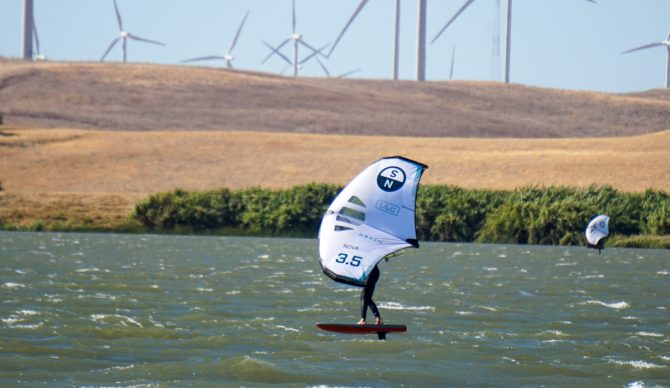
The North Nova Pro is well-tuned for all-around performance. Photo: Ken Cox//The Inertia
All-Around Wings
Versatile | Balanced | Best for Most Riders
Both the largest and most nebulous category, all-around wings do just about everything well. If you’re in the beginner/intermediate camp, these are the wings we would point you towards, but that said, there’s a lot to love here for more advanced riders as well – though racing-afficionados may want to look at the “high performance” wings below. Stable and predictable with great power delivery, these wings are the true quiver killers for those looking to take on a variety of different riding styles.
Versatile and Powerful
Duotone Unit 2026
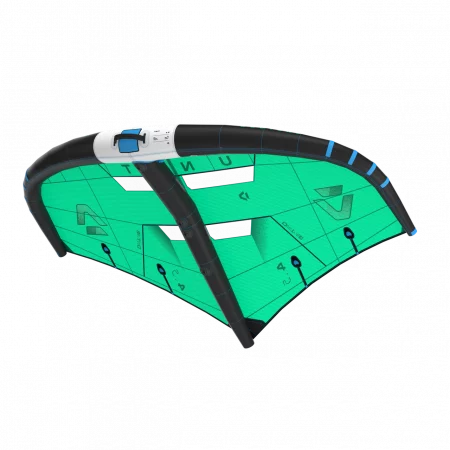
Price (4m): $1099
Handles: Hard handles or boom
Windows: Yes
Best For: All-around
Defining Characteristics: Grunty, good at everything
Pros: Super stable in the air, direct response with firm wing design/construction, boom and hard handle options
Cons: Boom or handles not included
Duotone has made some slight but noticeable improvements to the Unit for 2026, positioning the wing as their highest performing option, with the Slick being discontinued moving forward. For the past couple of years, the Unit has sat between high-performance maneuverability and all-around user-friendliness, but the 2026 changes truly elevate the offering into the “all-around high performance” sub-category.
The wing retains the Duotone Fusion handle system that was introduced in 2025, providing options for either a boom or hard handles. We’re big fans of this system overall. Both the handles and boom are very light, have a very stiff and direct connection to the wing, and are exceedingly comfortable. Other improvements to the Unit for 2026 include better stability while flagged out and more control when doing so, thanks to a stiffer front handle. Both of these were gripes of ours with the previous Units, so it’s great to see Duotone working to improve based on rider feedback. Other improvements include some tuning enhancements to the shape and canopy for better top-end performance and upwind angles, as well as a more responsive ride, positioning the Unit as Duotone’s highest-performing offering in wings.
Despite these high-performance modifications, overall, the Unit remains one of the more user-friendly wings on the market. The improvements to its surfability are notable, but it is still not what we would consider a “surf wing” as its moderate dihedral makes it a bit squirmier when flagged out than, for example, the Duotone Float or F-One Swing. However, for those looking for a wing that can do it all, the Unit is a compelling choice. It’s worth noting that the Unit does not come with handles or a boom, which must be purchased separately.
The Unit is available in a standard construction, the D/LAB Aluula construction, and an SLS construction that bridges the gap between the two with an Aluula center segment of the leading edge, adding stiffness where it is most needed.
check price on MACkite See the D/LAB Unit on MACkiteDoes Everything Well
Reedin Supernatural 2025
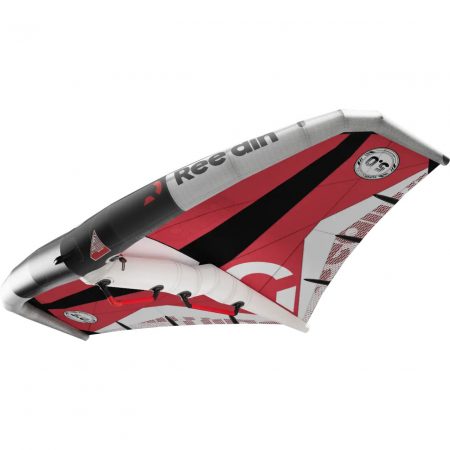
Price (4m): $985
Handles: Hard (option for a boom)
Windows: No
Best For: All-around/surf
Defining Characteristics: Great handles, all-around performance
Pros: Snappy canopy, great handles, predictable and easy-to-use
Cons: Not a standout in terms of upwind performance
Reedin is a brand that’s been a bit off our radar in the wing market. The brand has produced some interesting designs, like the see-through SuperWingX, but we felt it had yet to hit the mark in this highly competitive field. Last year, Reedin unveiled the Supernatural 2024, and wowed us all with a super versatile design that does everything pretty darn well. Stable and predictable in flight with tons of on-demand power, the wing is easy to gybe and tack; it even surfs very well, though not quite as well as a surf-specific wing. The Supernatural 2025 takes things to the next level with subtle refinements that don’t change the overall versatility we’ve come to love about the wing.
One of the wing’s standout features is the handles. While many wing manufacturers are moving to booms, one thing that inhibits this is the integration of a pistol grip for wave riding. The Supernatural has a massive front pistol grip, making it super easy to hold the wing in a semi-luffed grip for extended periods of time. Holding the wing in a pistol grip offers more control and lets the rider quickly grab the back handle for a boost of power as needed. However, with a two-handle design (as opposed to a boom), one-handed riding is off the table for those stylists among us.
For 2025, the wing has seen minor refinements, such as a stiffer front handle and carbon reinforcements in the leading edge for improved stiffness without adding weight. This also allowed Reedin to reduce the diameter of the leading edge for better upwind ability and performance in strong winds. However, the wing is not too stiff and retains that snappy, lively feel which gives it some extra grunt when pumping up onto foil. Finally, the wing is now available with a boom configuration for those who prefer a boom over hard handles.
check price on MACkiteUser-Friendly
Slingshot Slingwing V6

Price (4m): $989
Handles: Boom
Windows: Yes
Best For: All-around
Defining Characteristics: Grunty and easy to use
Pros: Great power, direct response, improved aerodynamics and freeflight over the V5 version
Cons: Not the highest-performing design that we have encountered
Slingshot made some significant improvements to their iconic Slingwing with the V4 design, introducing hard handles, windows, and an overall improved layout and stiffness. The Slingwing V5 built upon these improvements, with stiffer handle-to-wing connections and the inclusion of a boom as standard (and included in the total price). The Slingwing V6 makes subtle improvements to the overall design, reducing the dihedral for better free-flight performance and an overall more streamlined profile for smoother transitions and better upwind ability. Supremely user-friendly, this is a compelling choice for those looking for a versatile all-rounder.
The wing’s gruntiness is an aspect that’s great for those learning to foil, helping pull the rider up on foil in the beginning stages of the learning process. The V3 and V4 were already very grunty wings, and the V5 built on that with added stiffness for improved responsiveness when pumping. The new Sling Grip Uni Handle is another major improvement, as we are big fans of boom wings for easier hand placement. The connections from the wing to the handle are also vastly improved, offering a more direct feel and response.
The wing is a great choice for beginner or intermediate riders with its user-friendly design. However, advanced riders will likely find themselves better served by a wing more geared towards high-performance riding.
check price on MACkiteGreat for Intermediate Riders
Cabrinha Mantis V5
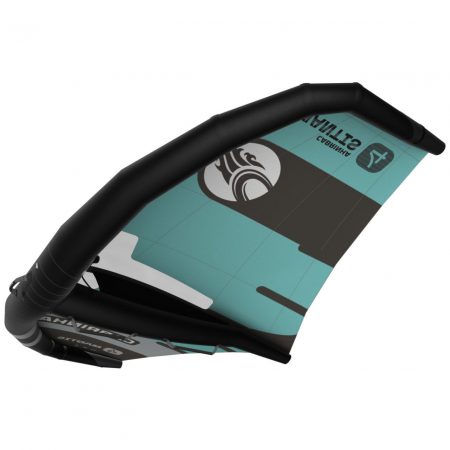
Price (4m): $1,019
Handles: Hard
Windows: Yes
Best For: All-around/surf
Defining Characteristics: Incredible control, great handles
Pros: Extremely versatile wing, stiff construction
Cons: All-around design isn’t a standout in any category
Cabrinha made some subtle, but fairly impactful improvements in their design of the V5 Cabrinha Mantis. The canopy material and layout have been improved, with specific improvements made to the trailing edge stiffness thanks to new rigid battens and a load distribution panel to reduce wingtip flutters. And the wing is now able to be converted to a boom, with Cabrinha’s new “Handle Bar Boom.”
Performance is top-tier, with an all-around, bordering on high-performance profile that delivers solid upwind potential, plenty of on-demand power with a stiff and responsive construction, but not so much grunt that we felt ourselves getting yanked around when riding in overpowered conditions. When flagged out, the wing is super stable, perhaps not as light-feeling as surf wings like the F-One Swing, but the rigid front handle provides a ton of control when the wing is depowered.
That brings us from performance aspects to features. And that’s an area that this wing really excels. Massive, well-placed windows provide a ton of visibility while riding. The hard handles are comfortable and responsive with an angled design that allows for a more comfortable riding experience. Furthermore, it’s very easy to hold the front handle in a pistol grip, which is useful for riding waves. And the potential for a boom is sure to excite the freestylists among us.
It’s a bit difficult to categorize this wing. In comparison to the Vision, another popular wing in Cabrinha’s line, the Mantis is a bit more of a high-performance design with a flatter layout that also gives it some solid wave-riding chops. The rigid front handle helps out there as well.
However, in doing just a bit of everything, we found the Mantis doesn’t exactly excel in any one category. For true beginners, we’d recommend a slightly more user-friendly wing, and for advanced riders, we’d likely point them in the direction of something more specialized for their style of riding. That said, being good at just about everything makes the Mantis a compelling intermediate wing, perfect for those with the skills to make use of the higher-performance aspects of the wing, might be edging into surf or speed-style riding (even freestyle with the new boom), but is not yet ready to start tailoring their wing choices to any specific discipline.
check price on MACkiteInterchangeable Handles
North Nova Pro
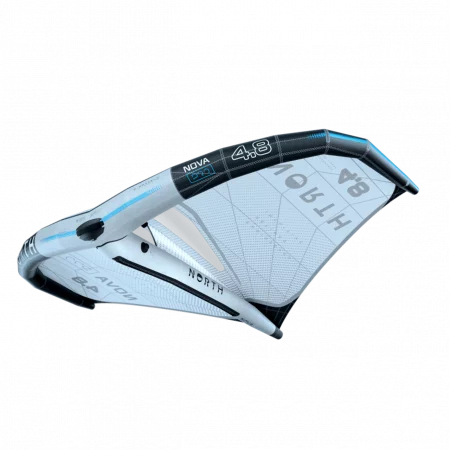
Price (4.2m): $1,369
Handles: Interchangeable: hard handles or boom (not included)
Windows: Yes
Best For: All-around/freestyle
Defining Characteristics: Stiff and responsive, interchangeable handles, powerful
Pros: Super stiff, lightweight, interchangeable handles give tons of customization
Cons: Interchangeable handles are tricky to get on and off
North’s Nova is their all-around, user-friendly wing for foiling. The Nova Pro is by no means a less user-friendly wing, but it has some significant and interesting upgrades over the base version. First of all, the materials. North uses a special N Weave 45 material for the frame and what they call Matrix material in the canopy. While the words are just marketing-speak, the difference in materials is palpable, especially in the frame of the wing, with a rock-solid feeling that helps in both under- and overpowered conditions.
Another interesting upgrade, and adding to the wing’s overall stiffness, is North’s new Shiftlock handle system, which uses two thin rails integrated into the center strut that the hard handles or boom (your choice) latch onto. The connection is super secure and quite rigid, providing a very direct response in controlling the wing.
The rails themselves add a bit of stiffness to the wing, as does the boom if you choose to go that route. We did discover one frustrating downside to the boom, however, as, like most boom-style wings, to pack it back into the included carry bag, you’ll have to take off the boom. Unlike most boom-wings, however, that process requires a Torx screwdriver (T40 to be exact) to unclamp the boom from the tracks. While that’s not the biggest deal, and may be a non-issue for some, we’re all about simplicity, so we felt this was worth noting. The handles and boom also need to be purchased separately from the wing.
check price on MACkiteHonorable Mentions
There are a couple of wings we’d like to mention here. First off is the KT Wing Air Direct Drive. Although it’s difficult to find online at the moment, we’ve seen a few of these pop up at our local waters recently, with some major improvements over the prior version. Now with windows and the option for a boom, this grunty and wave-oriented wing gets the update it deserves. Now it’s just a matter of finding it in stock.
We’d also like to give a nod to the Naish ADX. We only had limited time testing the latest version of this wing at the AWSI Expo in September 2024, but we liked what we saw. Stiff and ergonomic hard handles, and a grunty, compact outline stay true to Naish’s roots as a surf-oriented brand.
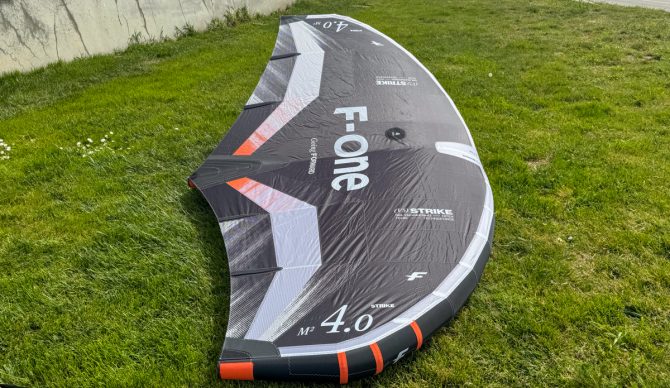
The F-One Strike V5 is a true weapon for high-powered riding. Photo: Will Sileo//The Inertia
High Performance Wings
Fast | Responsive | Efficient
These are the wings made for those with the ability to eek every last shred of performance out of them. Looking for better upwind angles? Explosive hangtime? The stiffest, lightest, and most reactive wings on the market? Look no further.
All-Around Shape with a High Performance Bent
Armstrong XPS Mk II
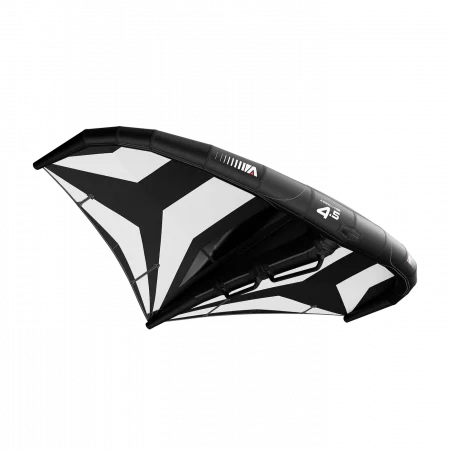
Price (4m): $1,129
Handles: Hard, boom
Windows: Yes
Best For: All-around performance
Defining Characteristics: Stiff and responsive, compact wingspan
Pros: Stiff construction, all-around style of wing with a high-performance bent
Cons: Speedy, but not race-specific if that’s what you’re looking for
The XPS is a wing that is almost impossible to categorize. Loved by advanced and beginner riders alike, this wing seamlessly bridges the gap between all-around and high-performance wings. It also surfs incredibly well. With a super stiff construction, it offers solid low-end grunt as well as an incredible top-end, although there are better wings out there for racing if that’s what you’re looking for. Like the Armstrong A-wing before it, the XPS luffs quite well, and the improved depower handle on the front of the wing is quite stiff, providing a very direct response when the wing is luffed wave-riding, all the better for making sure it stays out of your way. The stiff construction makes the wing much more capable in the high-end, and less prone to flexing/deforming when overpowered.
For 2025/26, Armstrong released the XPS MkII, which makes some subtle improvements to the wing’s overall shape and construction, and big improvements to the handle design. A lower-aspect airframe adds more stability, while the leading edge diameter has been reduced for better upwind efficiency. Finally, one of the biggest improvements to the wing (in our opinion) is the change in the handles. They’re now removable, interchangeable with a boom or hard handle options, and improved ergonomics with a cylindrical piece of carbon wrapped in EVA for grip. We weren’t the biggest fans of the prior-generation handles, which were a bit flatter, wrapped in fabric, and overall not our favorite handle design. For all-around high-performance use, this is one of our favorite wings on the market right now.
check price on REAL WatersportsSuper Stiff, Direct Control
F-One Strike V5
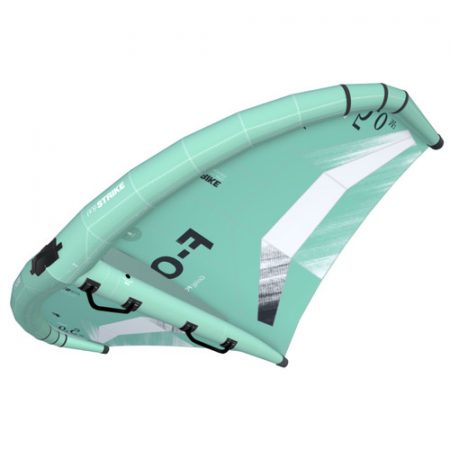
Price (4m): $1,199
Handles: Interchangeable: Soft, hard handles, boom
Windows: No
Best For: Advanced riding, freestyle, speed/efficiency
Defining Characteristics: Fast, performs when overpowered
Pros: Very light, stable in the air, and in higher winds, stiff construction, interchangeable handles
Cons: No windows, can be a bit twitchy for beginners/intermediates
F-One’s Strike has been a consistent top-tier performer for us throughout the years we’ve been working on this review, and the Strike V5, just released this spring, ups the ante significantly. Already one of the stiffest and most direct-feeling wings we’ve tested, the improvements made here are ones you are likely to feel, rather than see.
The Strike has always been a high-performance wing designed for speed, but this year’s version takes that a bit further. The Strike is a wing that thrives in the high-end and is not easily overpowered, but it sacrifices some grunt to get there. You’ll likely be happier riding this wing slightly overpowered than slightly underpowered. All that said, this generation of the Strike has a vastly improved low end over previous models. It’s still a wing that prefers high power conditions, but thanks to some subtle canopy and shape improvements, it’s now far more capable in the low end. That improved grunt is also a boon for freestyle riders in recovering and riding out from tricks to have a bit more “oomph” to stay airborne. And the stiffness and direct control of this wing cannot be understated. This wing slips and zips through the wind window, maneuvering itself to precisely where you want it to be.
Another big plus of this wing is the interchangeable handles that were introduced last year. This lets riders choose from a variety of different handle options (hard, soft, semi-soft, or boom). And swapping handles in and out is a breeze, with simple fabric loops that the handles are inserted into, and kept in place by the wing’s air pressure. Another, very small but significant detail is the two-way inflation valves on the F-One and Duotone wings. These valves, over the standard one-way, allow for precise pumping with a hand pump, taking a certain amount of guesswork out of the inflation process.
The only real ding we had on this wing is the lack of windows, which some will care about, and others won’t. For more info on windows, check out our buyer’s guide. The high-powered needs of the wing also make this less of an all-around wing. This is certainly not the wing we would recommend to a beginner, but for those who know what they are doing, and in the right conditions, the efficiency and control of this wing are pretty incredible.
New this year, the Strike is being offered in a semi-Aluula construction, for maximum stiffness and light weight. We’re already super impressed with the Strike’s stiffness, but if you demand the best of the best for your riding, check out the Strike Aluula.
check price on MACkiteSpeedy and Surfy
Ozone Flux V2
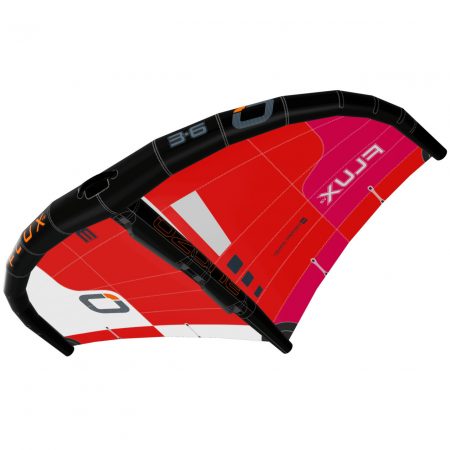
Price (4.3m): $1,242
Handles: Hard, semi-padded
Windows: Yes
Best For: High-performance speed, surfing
Defining Characteristics: Fast, stable, luffs well
Pros: Great mix of speed/high-powered riding and stability for wave-riding
Cons: Inflation valve doesn’t lock on, a minor inconvenience when pumping
The Ozone Flux has been a widely celebrated and well-loved wing design. When it came out a couple of years ago, it was at the forefront of the freeride/freerace trend in wing design, which now appears to have overtaken the industry. This style of wing prioritizes speed, overall efficiency, and stiff, responsive handling. That also translates a bit into stable freeflight and easy control for use in waves.
The Ozone Flux fits these criteria perfectly as a wing that is entirely built around speed. The wing thrives in high-powered conditions, with a super stiff construction, updated materials, and a well-designed panel layout that helps it handle overpowered conditions and improve the wing’s lifespan by keeping it from bagging out too quickly. At Crissy Field in San Francisco (where our lead tester rides), the Ozone has quickly become one of, if not the, most popular wing to ride due to the speed and on-wave performance.
The Ozone Flux V2 takes things to the next level. The stiffness of the wing has been improved, as well as overall handling and efficiency, making for a faster, more maneuverable wing, capable of even better upwind angles than the prior version. However, despite all these race-oriented features, the wing has proven itself to be a great choice for waves as well, with impressive stability when luffed. The V2 also sports a stiffer front handle for better control when flagged out.
The materials, as well as being stiff, are quite lightweight, and the hard handles are shaped to allow a semi-luffed, one-handed “pistol grip” on the front handle, a design that many wing manufacturers are starting to incorporate. The V2 version has increased handle rigidity and extended the front handle to allow for one-handed riding. If you’re looking for a high-performance wing that can truly do it all, the Flux V2 is one of the strongest contenders on the market.
Inflation is two-point, with the leading edge and strut being inflated separately. Really, our only complaint about the wing is that it uses a non-locking Boston-style valve, which can be a bit finicky when inflating.
Similar wings include the F-One Strike, which similarly thrives in the high end, and being very lightweight, is a solid choice for riding waves as well, though in our testing, we found the Strike to be a bit jumpier when luffed than the Flux, and perhaps a bit more capable in overpowered conditions.
check price on MackiteAluula Performance
CORE Halo Pro

Price (4m): $2,050
Handles: Boom
Windows: No
Best For: High-performance speed, surfing
Defining Characteristics: Fast, stiff, luffs well, and super lightweight
Pros: Super light and responsive, fast and stiff
Cons: Non-removable boom complicates packing/travel
Another Aluula wing that has become a favorite of the high-performance wave-riders of Crissy Field in San Francisco (where much of the testing for this review took place) is the CORE Halo Pro. It feels a little bit like cheating to include a true Aluula wing with the rest of these, mostly traditional-construction Dacron wings, but there’s no doubt that the Halo Pro deserves a mention, and there is (currently) no non-Aluula version to include here, as CORE’s non-Aluula wing, the XC, has a very different shape and riding profile. That said, CORE was showing off its new non-Aluula CORE Halo wing at the 2025 AWSI, so we’ll be sure to update this review once that wing lands on the market.
The Halo Pro is best described as a freeride/freerace wing, but it also surfs incredibly well. The Aluula construction results in a very light wing, aided by the inclusion of a boom instead of handles. Super snappy with a very direct-feeling response, the Halo Pro rips upwind, through tacks, and is very easy to work around in transitions while riding waves and swell. Flagged out, the lightweight construction keeps this wing in the air instead of dragging on the water, and a nice surf handle up front makes it easy to control while luffed. While the twitchiness of the stiff construction (and the price) would be a bit daunting for beginners, we were quite impressed with the user-friendliness of this wing. It certainly isn’t the gruntiest on the market with more of a race-oriented profile made to cut through the wind, but the direct feeling makes it super easy to pump up onto foil in lighter winds.
Our biggest gripe with this wing is that the boom is not removable. That provides a bit of a concern for travel, as it can be difficult to pack down. The price is also fairly steep, as previously mentioned, but that should come as no surprise for an Aluula wing.
check price on REAL WatersportsStrong and Durable
North Mode Pro
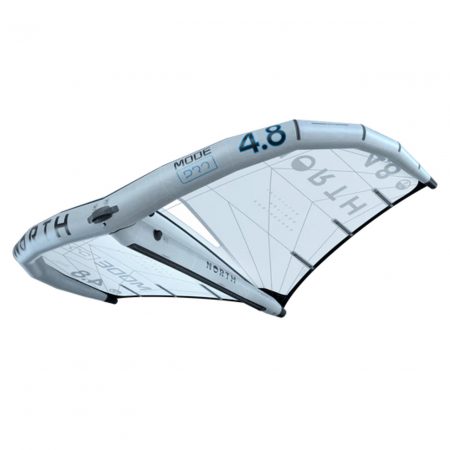
Price (4.2m): $1,519
Handles: Interchangeable
Windows: Yes
Best For: High-performance speed
Defining Characteristics:
Pros: Great wind range, stiff and responsive, lots of handle options
Cons: A bit heavier-feeling than other high-performance wings, handles not included
North’s Mode series of wings has gained many loyal customers over the years, and the 2025 Mode Pro takes the well-loved design and gives it a few key upgrades. First off, the handles. North’s Pro line of wings (the Nova Pro, Loft Pro and Mode Pro) uses North’s ShiftLock handle system, which lets you choose between a boom or a few different styles of hard handles to suit your preferences as a rider, as well as attachments for an action camera, or SUP paddle for upwind/downwind runs. For 2025, the Mode Pro integrates this ShiftLock system. The handles are quite comfortable and provide a very direct response to the wing, being securely locked on. However, that secure connection does require tools to set up, so it’s worth noting that it’s not super convenient to have one boom or set of handles that you could swap between wings in your quiver.
Other improvements for 2025 include a radial canopy layout for better tension and durability, and overall made minor improvements to the wing’s aerodynamics. In testing, we’re huge fans of what North has cooked up here. The wing is fast and highly responsive, with a wide wind range and great top-end. In comparison to North’s Nova Pro, the Mode is faster and has less grunt in the low end. It also (in our opinion) surfs better, despite the Nova being North’s more wave-oriented wing. Due to the Mode’s flatter dihedral, we found that it was a bit more stable than the Nova when flagged out.
One small knock is that we found the Mode Pro to feel a bit heavier than most other high-performance wings we tested. That’s less of an issue for powered-up riding, but when flagged out, it had more of a tendency to drag in the water than wings like the Ozone Flux or CORE Halo Pro. That said, one pro to the heavier construction is durability. This wing is one you can expect to last you for years of continuous, high-performance use.
check price on MACkiteHonorable Mentions
Another high-performance wing we’d love to mention is the PPC M1-X, engineered with Dyneema for a super-stiff frame. We’ve spent some time on the M1-L, which only uses Dyneema in the center segment of the leading edge, and were stoked on the stiffness, and snappy, direct canopy. However, we found the M1-L isn’t that much cheaper than the M1-X (about $1,500 compared to the M1-X’s price of $1,800), which kept it out of the running for us. When we are able to test the M1-X, it will likely find a home in this review based on the overwhelmingly positive feedback it has received.
This tees up another high-performance standout, but one that is so specialized that, unless you’re seriously interested in wing foil racing, it likely won’t have a place in your quiver. That wing is the Ozone Fusion, a dual-skin design made to slice through the wind with maximum efficiency and speed. Now in its second iteration as the Ozone Fusion V2 Ultra X, the wing comes packed with upgrades, including the addition of Aluula material throughout the frame of the wing for maximum stiffness and lightness. We’ve heard plenty of rave reviews about this wing from the racers at our local wind spots.
Finally, we’ve got to give some props to the now-discontinued Duotone Slick. For 2026, the Unit is moving in to replace the Slick as Duotone’s high-performance wing, but past versions of the Slick still provide that user-friendly high performance which made it such a standout in the first place.
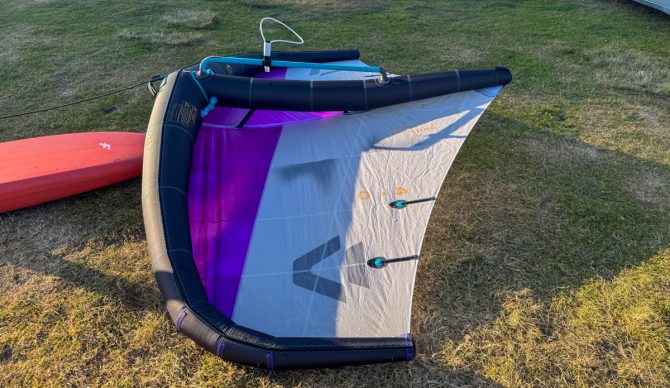
The Duotone Float provides just about everything you could ask for in a surf-style wing. Photo: Will Sileo//The Inertia
Surf Wings
Drifty | Compact | Tuned for Wave Riding
If your goal in winging is to ride a wave with nothing holding you back, a surf wing is the way to go. These wings are optimized for effortless drift and easy control from the front surf handle. Lightweight and compact, these wings will stay out of your way while you find your flow on waves, wakes, or swell.
Stiff and Lightweight
F-One Swing
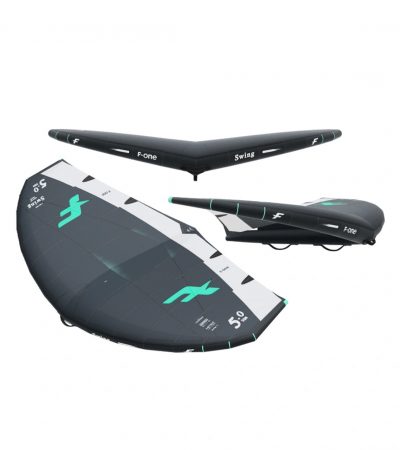
Price (4m): $1,249
Handles: Interchangeable: Soft, hard handles, boom
Windows: No
Best For: Wave-riding, freeride
Defining Characteristics: Grunty, direct response, stable when luffed
Pros: Very light, stable in the air and when luffed, plenty of grunt lets you ride a smaller size
Cons: No windows, not as much upwind efficiency/speed as the Strike
A couple of years ago, the Swing was F-One’s entry-level wing. With the V3 Swing, that changed slightly, as some subtle improvements were made to give this light and grunty wing better luffed performance for a stable and intuitive wave-riding experience. That trend continues with the v4 Swing, making it far and away one of the best wave-riding wings we’ve tested. Even with the new (optional) hard handles attached, the wing maintains a very low weight, and the flatter dihedral helps keep it steady and makes it very easily controlled when flagged out. Notably, F-One just released the V5 Swing, and we’ll add some new notes here once we’ve gotten our hands on it for testing.
The wing benefits from the same stiffness improvements that were made to the Strike over the past couple of iterations, giving it tons of direct control, a huge boon when coming off of a wave and needing a quick boost of power to stay on foil and get out past the break for another ride. The extra gruntiness also allows you to ride this wing a bit smaller than many other wings out there, which, along with the compact wingspan, makes this wing highly maneuverable and easy to manage both under power and when luffed for swell/wave-riding. Despite all of these “wave-specific” features, we found that the Swing is still a very solid wing in higher winds, and has great upwind efficiency, though the F-One Strike and other, more speed-oriented wings will be a better choice if high-powered riding and speed/efficiency are your priorities.
check price on MackiteIncredible Luffed Performance
Duotone Float
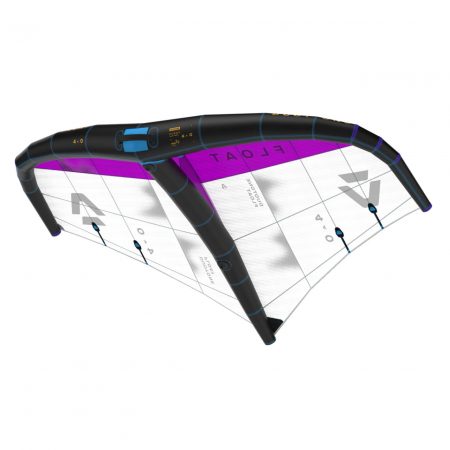
Price (4m): $929
Handles: Boom
Windows: No
Best For: Surf
Defining Characteristics: Super stable and lightweight when flagged out
Pros: Extremely stable in freeflight, great price
Cons: No windows, boom not included
In our opinion, Duotone has been a bit behind when it comes to surf-style foiling gear. But the Duotone Float proves that good things come to those who wait. With a super-simple, lightweight, and easy-to-use design, this wing was designed, first and foremost, to flag out and stay out of your way while riding waves or ripping swells. And it does so beautifully. The lightweight design keeps the wing in the air and out of the water, aided by the stable design and a nice, stiff surf handle that lets you put the wing where you want it (out of the way) when flagged out. Make no mistake, this wing is perhaps the easiest and most intuitive wave-riding wing we’ve tested. It’s a pretty fair toss-up between this wing and the F-One Swing for luffed-out performance, and we’re eager to put the two best wave wings on the market to a head-to-head test when we get our hands on the latest F-One Swing (the V5 Swing is due to launch sometime this summer).
And while the Float is undoubtedly optimized for flagged-out performance, when riding, it’s certainly no slouch. A very well-balanced design, the wing has solid upwind potential, not as good as most high-performance wings we’ve reviewed, but we were pleasantly surprised to see that upwind performance is not a weakness of the Float. Overall handling is very intuitive, and the wing’s lightweight design feels great when maneuvering through tacks and gybes.
The boom is a slightly controversial choice, and really, the only downside we could think of when it comes to this wing. On the pro-boom argument, it reduces the wing’s overall weight and allows for one-handed riding. The downside is the packability (the boom is removable for travel, but requires a screwdriver to do so) and the lack of a pronounced pistol grip at the front of the boom for semi-luffed riding. If you want a wave wing with more handle options, the Swing is a great choice.
check price on MACkiteHonorable Mentions
The Ozone Flow is another wave-oriented wing we’d like to give some props to. Although we’ve had very limited time on this wing, it certainly impressed us in testing. It’s a bit more of an all-rounder shape than the two wings above, with more dihedral, but it flags out incredibly well.
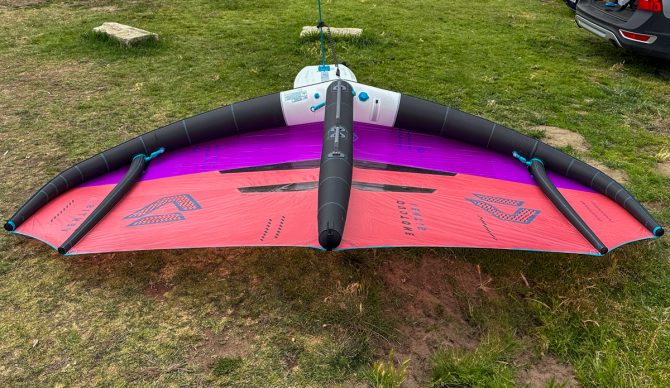
The Duotone Ventis uses extra struts for added stiffness and a more compact wingspan. Photo: Will Sileo//The Inertia
Light Wind Wings
Powerful | Lofty | Engineered for Marginal Conditions
If the places you ride have more days below 12 knots than days above, or if you want to make use of the days where the wind is barely reaching double-digits, a light wind wing is your ticket to getting on foil earlier, and with less effort. A big board and big foil won’t hurt, either.
Traditional and Aluula Options
Duotone Ventis
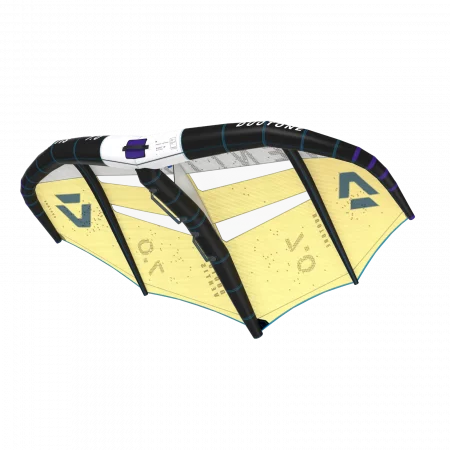
Price (7m): $1,519
Handles: Hard
Windows: Yes
Best For: Light wind
Defining Characteristics: extended front handle, extra struts
Pros: awesome lift and power for super low-wind conditions, extended front handle allows for one-handed riding, Aluula construction provides stiffness and light-weight that vastly improves the light-wind experience
Cons: Aluula construction is expensive
Based on our research, there are three top-tier light-wind wings in the industry: Those are the F-One Strike CWC, the Duotone Ventis, and the North Loft Pro. The Duotone and F-One wings benefit here from a design that was pioneered a couple of years ago by F-One, the CWC (Compact Wing Concept). The CWC construction involves two extra struts on either side of the main one, which give the wing extra stiffness in relation to the size, and allow for more square meters of wing to be packed into a smaller wingspan. This design gives wings like the CWC and Ventis improved all-around performance, from maneuvers to upwind potential.
For the “2025” version, the Ventis received a few refinements. The windows are bigger, and the overall shape of the wing has been updated to provide better upwind potential and an easier time getting up onto foil with a reduced wing-tip design. The wing is available in two constructions, Duotone’s regular construction and the D/LAB construction, which uses Aluula material in the struts and leading edge, as well as a lighter-weight canopy material. The stiffness and lightness of Aluula are a winner for light wind and bigger wings, but it costs quite a bit extra.
We’re also big fans of the extended front handle on the Ventis, unlocking one-handed riding. For our tester, that was actually a fairly significant point of difference. In lighter winds, there are often fewer “fun” things to do out on the water. You likely won’t be finding any windswell to ride, and the lack of wind can make gybes and other maneuvers more difficult. With that in mind, light wind can be a great time to experiment with fun and less technical foil tricks, like riding one-handed.
Between the Ventis and the F-One Strike CWC, it’s a pretty fair toss-up in terms of overall performance. If you are looking for the best price, the base-model Ventis will provide the best bang-for-buck, but for a few hundred dollars more, the Strike CWC adds Aluula to critical areas for an overall lighter and stiffer wing. If your wallet can handle it, the all-Aluula Ventis D/LAB will provide the lightest and stiffest light wind experience on the market.
check regular-construction price on MACkite check D/LAB (Aluula) price on MACkiteSemi-Aluula Construction
F-One Strike CWC
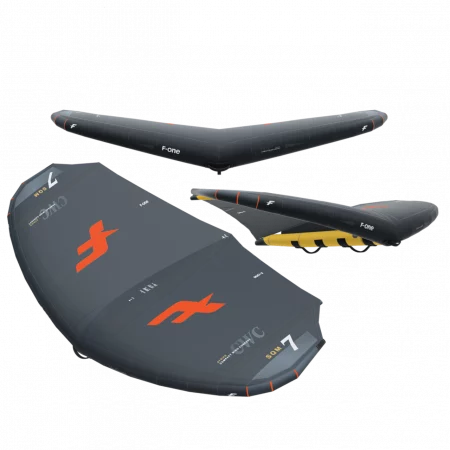
Price (6m): $1,769
Handles: Interchangeable
Windows: No
Best For: Light wind
Defining Characteristics: Three-strut design
Pros: CWC construction packs a punch in light winds
Cons: Still a huge wing
When it comes to light-wind winging, light and stiff is a winning combination. That’s why, for 2024, F-One is integrating the renowned top-tier stiff and light material, Aluula, into their Strike CWC light wind wing. Notably, the Aluula is only used in the struts (not the leading edge), and there isn’t a non-Aluula version available – most companies that make an Aluula wing also have a non-Aluula version for those unable to swallow the much higher price point that comes with the high-end material. However, since the Aluula material is only used in the struts, this is actually one of the cheaper Aluula wings on the market for its size.
Design-wise, the Strike CWC looks a bit different from your usual wing, using two extra inflatable struts off the leading edge to add stiffness and allow it to pack those extra square meters of wing into a tighter and higher-performing package. The wing is available in sizes from 6 to 9m.
Of note are the wing tips, which feature cut-outs to help the user recover from wing-tip strikes faster and easier. And that’s a big deal, as with such a big wing, wing-tip strikes are somewhat inevitable. On that note, it’s also worth mentioning that bigger is not always better when you reach this size of a wing. In theory, a 9m wing should get you off the ground in just about any puff of wind, but in practice, unless you’re well over six-feet tall, a 9m will likely be far too much wing to handle and keep the tips out of the water, especially while pumping to get up on foil in the presumably light wind that you’ll be using it in. Consider the foil and board you’ll be pairing with this wing, and if you can, use a larger foil or board to keep your wing size more manageable.
check price on MACkiteHonorable Mentions
We’ve heard a lot of great things about the North Loft Pro, but have yet to get out on the water with it. We’ll be sure to update this review when we are able to do so.

This was a serious test. The Inertia’s Will Sileo, ahead of a boat wake. Photo: Skyler Fitzmaurice//The Inertia
Best Wings for Wing Foiling Comparison Table
| Wing | Price (4/4.5m) | Best For | Handles | Windows |
| Duotone Unit 2025 | $1099 | All-around | Hard or boom (not included) | Yes |
| Reedin Supernatural 2025 | $985 | All-around/surf | Hard (or boom) | No |
| Slingshot Slingwing V6 | $989 | All-around | Boom | Yes |
| Cabrinha Mantis V5 | $1,019 | All-around/surf | Hard (boom option) | Yes |
| North Nova Pro | $1,369 | All-around/freestyle | Interchangeable | Yes |
| Armstrong XPS MkII | $1,129 | All-around performance | Hard or boom | Yes |
| F-One Strike V5 | $1,199 | Speed/efficiency, freestyle | Interchangeable | No |
| Ozone Flux V2 | $1,242 | High-performance speed, surf | Hard | Yes |
| CORE Halo Pro | $2,050 | High-performance speed, surf | Boom | No |
| North Mode Pro | $1,519 | High-performance speed | Interchangeable | Yes |
| F-One Swing V5 | $1,249 | Surf/freeride | Interchangeable | No |
| Duotone Float | $929 | Surf | Boom | No |
| Duotone Ventis | $1,519 (7m) | Light wind | Hard | Yes |
| F-One Strike CWC V4 | $1,769 (6m) | Light wind | Interchangeable | No |
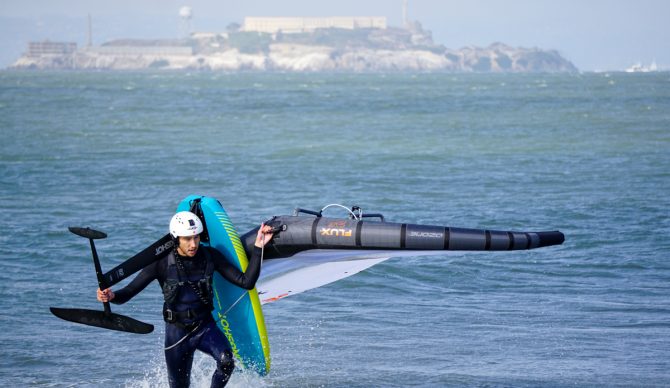
Senior Gear Editor Will Sileo gets in some testing time at Crissy Field. Photo: Carmelo Banados//The Inertia
How We Tested The Best Wings for Wing Foiling
We winged with them, of course. The Inertia’s Senior Editor Joe Carberry and Gear Editor Will Sileo have spent the past few seasons on the latest and greatest wings out there. Neither are pros by any means, but both are proficient wingers who know a good wing when they see (and feel) one. And not being paid to wing does give us a certain amount of neutrality, which a sponsorship wouldn’t allow for. No brand paid us for inclusion in this review, and as with all of our reviews, our first loyalty is to you, our readers.
Overall, we’ve spent a lot of time in the water on these wings and would stand behind any wing included in this review as an incredible option for the sport of wing foiling, whether you’re just starting out or looking for a wing that will boost you skyward.
It’s hard to talk about power when comparing different-sized wings in varying conditions, so with this first foray into the category, we did our best to stick to the features and design elements that made each wing in the review unique. We’ll be putting significant effort into keeping this article updated as we’re able to try new wings this season and continue to ride the wings we’re currently testing.

Our tester, getting after it in the shadow of the Golden Gate Bridge. Photo: Skyler Fitzmaurice//The Inertia
Best Wings for Wing Foiling Buyer’s Guide
Best Budget Wing
You may have noticed that we left a “Best Budget” option out of our awards, above. That’s because, first of all, the “best budget wing” is a bit of an oxymoron when the “budget” item in question is likely well over $500, and also because the best budget wing is undoubtedly whatever is on sale.
With the insane amount of product development going on, and new models of your favorite wings coming out every season, there’s almost always a deal to be had on brand-new wings from last season. Sure, they might not have all of the latest and greatest features, but give it another season, and those “latest and greatest features” will already be obsolete. The reality is, all of these wings will do what you want them to, which is get you up on foil and enjoying the water. If price is your main consideration, we’d recommend whatever you can find that’s on sale.
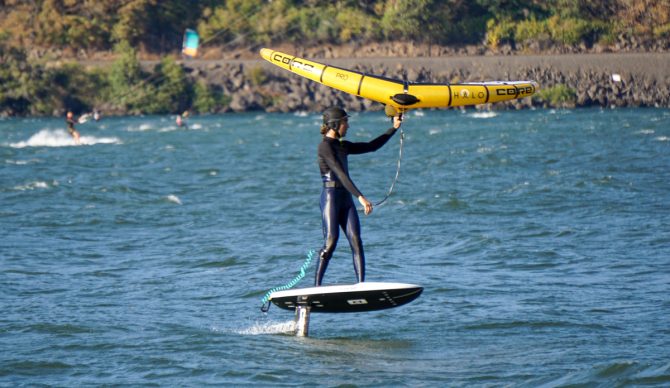
The CORE Halo Pro has a flatter dihedral and narrow profile, making for tons of speed upwind, and easy luffing while on a wave. Photo: Ken Cox//The Inertia
Dihedral and Wing Shape
The dihedral of a wing refers to the angle that the two sides of the wing make against each other. A flatter dihedral (such as on the F-One Swing Wing) is better for surfing and swell-riding, as the wing is more stable while depowered or “luffed”. A higher dihedral wing is stable in maneuvers and at speed, but when depowered is less stable than its flatter counterparts.
The wingspan and aspect ratio between the length and width of the wing also matter. A wing with a lower aspect ratio and therefore smaller wingspan will be more compact for maneuvers and pumping, while a wing with a higher aspect ratio tends to be more efficient in light winds and able to cut through high winds better as well for better upwind angles.
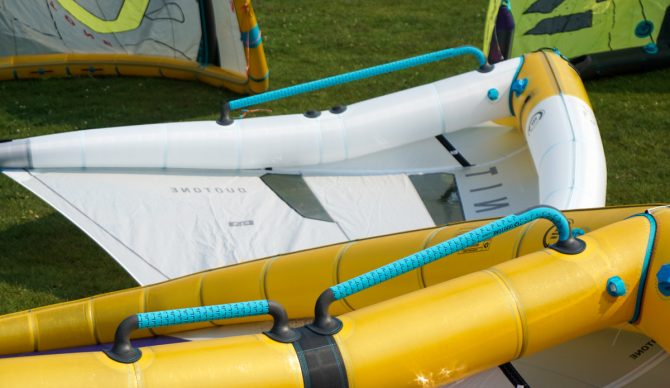
The Duotone Unit now offers the choice between hard handles or a boom. Photo: Will Sileo//The Inertia
Handle Design
This is perhaps one of the most rapidly changing areas of wing design. A couple of years ago, everyone had soft handles; now the majority of wing handles are hard handles, with a few hybrids and holdout softies in the mix. And booms are catching up – nearly every brand makes a boom wing now, or has the option to swap out for one with their wings. Next year, we wouldn’t be surprised to see boom wings as the majority.
Booms make a wing more rigid and reduce weight for luffing while riding waves or swell. They also provide an incredibly large target for swapping hands during turns, maneuvers, etc., you just might complete a higher number of your maneuvers with a boom-style wing. They’re a bit of a pain to pack up and travel with, adding yet another detachable piece of equipment to the mix, but overall, the benefits of a boom are hard to deny. They even allow for one-handed riding and other easy freestyle tricks to mix up your riding.
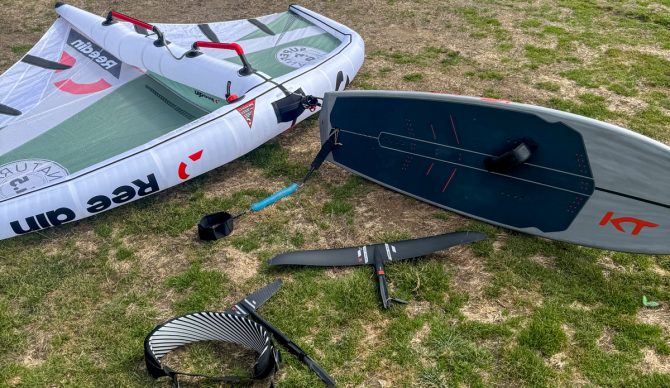
The front handle on the Reedin Supernatural provides a massive pistol grip for easy half-flagging. Photo: Will Sileo//The Inertia
Hard handles have become the industry standard. They seek to bring the best of the boom with the same simplicity and packability of a soft handle. And they come pretty darn close. All hard handles provide the same sort of direct response as a boom. Longer handles allow for the sort of trim adjustments that you get with a boom, at the cost of some weight. Some wings have a nice, long front handle that allows for one-handed riding, similar to a boom. Another pro of hard handles is the way they allow for a semi-luffed pistol grip. That’s often more difficult with a boom as they can’t quite make the same angle at the front of the handle due to their extended length, so there’s less room for your hand to fit in that pistol grip.
It’s also worth noting that hard handles may have more of a long-term durability problem for wings than other handle styles. Most wings in this review with hard handles do not have detachable hard handles, meaning they need to be packed up inside the wing when it’s stored in the carry bag it came with. There, the hard handles do provide a bit more potential for damage than other options. So far, however, we have yet to see any issues with hard-handled wings, but it’s a potential point of failure for sure. Some booms we tested are detachable, and the soft handles are not a concern for damage when packing.
Soft handles are being phased out relatively quickly nowadays. Even F-One has relented and last season began offering their wings with interchangeable handles so you can choose hard or soft (though the wings still ship with the soft handles).

Boom-wing testing day at Crissy Field. Photo: Will Sileo//The Inertia
Windows
For some reason or another, it seems like windows are the hardest part for wing manufacturers to get right. With most windows, we found ourselves straining to see through them, or needing to put the wing at such an awkward angle that a quick under-wing peep is almost easier. Our favorite windows are those on the Cabrinha Mantis and the Duotone Unit/Slick.
The Duotone wings have two vertically-oriented strips of window material that let you see a very narrow field of view – basically at any angle your wing might be at, whether you’re hauling hard upwind or catching swell on your toe-side. The Cabrinha wings have a horizontally-oriented (and fairly wide) strip of window material right above and below the center strut, allowing for a very wide field of view, with much larger window areas as the window gets close to the leading edge. It’s at the perfect position to see through when hauling upwind, as well as riding toe side, and is the best window that we have encountered thus far.
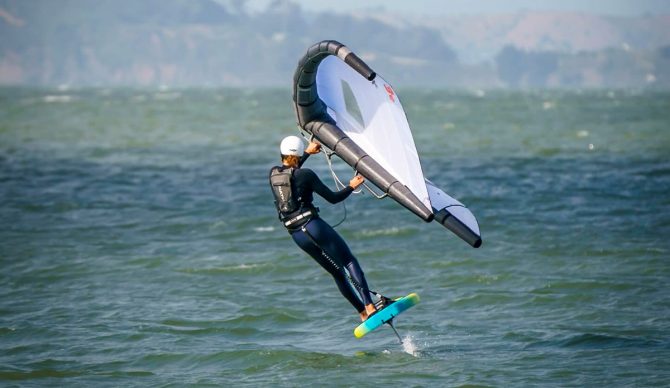
The Ozone Flux has horizontally oriented windows. Photo: Carmelo Banados//The Inertia
That said, some wings don’t have windows, and there are a few solid reasons why not. While windows do allow you to see while your wing is under power, as said above, the lining-up process can be tricky – unless the manufacturer gets the placement right, the windows are basically useless, and there are a couple of other drawbacks to adding windows to a wing. First, they do add some weight to the wing itself, and secondly, they are a potential long-term failure point that is fairly hard to repair properly. Written on the Unit wing itself, Duotone cautions the user to “avoid creasing the windows” when rolling up the wing, and that any damage due to such creases won’t be covered under warranty. Yikes.
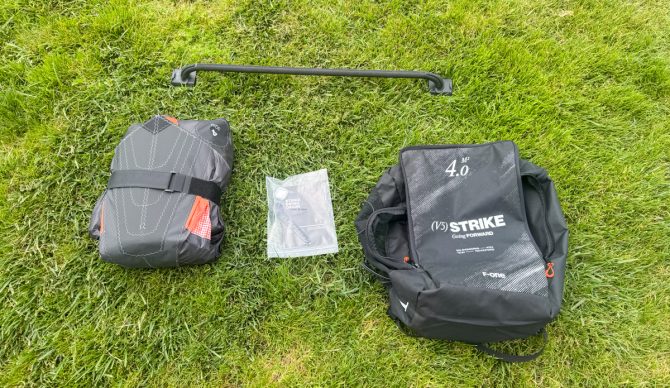
Wing, repair kit, boom, and bag for the F-One Strike V5 (boom available for purchase separately). Photo: Will Sileo//The Inertia
The Bag and Other Accessories
While we certainly wouldn’t determine the best wing based on how easy it was to get the wing back in its bag after a session, these often-neglected details can contribute to that windsports frustration that can turn a nuking session into one that makes you want to tear your hair out. Among the wings we tested, we found the bag for the Duotone and F-One wings to be the easiest to use, with wide openings and plenty of room inside the bag, which is also nice when you need to pack up a slightly damp wing – better for it to have some air than having that wet fabric super-compacted. With the boom wings hitting the market now, some manufacturers are moving to a longer bag shape, allowing you to pack away your wing without detaching the boom.
Other common accessories include a small repair kit for patching pinholes and other small dings, and, if necessary, an adapter for connecting to a regular pump connection. F-One and Duotone were the two wings in this review that required a pump adapter from the classic windsports pump valve, and (at least with the samples we tested) an adapter was included with both, but it’s worth double-checking if you’re switching from a different wing-valve system.

Sure, it’s not as important as what’s inside, but the bag can be a pain point, so it matters. Photo: Will Sileo//The Inertia
Info for Beginners
With winging being such a new sport, and its exploding popularity, there are a lot of people who are new to the sport. Heck, only a few years ago, we all were. Here are a few tips on wings for those who are just starting out. For more advice, check out our guide to The Best Wing Foil Gear for Beginners.
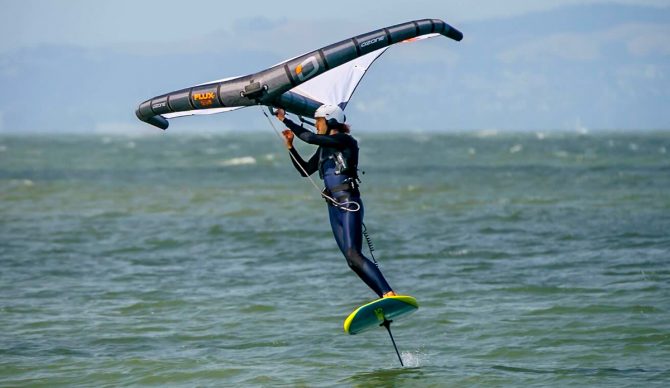
Senior Editor Will Sileo glides through a tack at Crissy Field on the Ozone Flux. Photo: Carmelo Banados//The Inertia
Wing Rules to Live By
There are a few things to remember when using wings. Most of us have a self-preservation mode, so it (almost) goes without saying, don’t buy a wing and take your foil out into the lineup. Find a forgotten wave if you want to learn to surf with a foil and wing – it ain’t as easy as it looks. The best place to learn is open water, a bay, or a lake, with no shore break to beat you up while you’ve got a four-meter piece of fabric in one hand and a hard board with a carbon-fiber saber in the other.
Winging and foiling are essentially two separate skill sets. Learn to foil by towing behind a Jet Ski or boat. Then learn to wing. However, they can essentially be done together if you’re willing to take your lumps. The wing allows you to de-power whenever you want, so you can simply learn to move with speed before getting up on foil. But flatwater is definitely recommended.
There are places to get wing lessons, but they’re generally in wind-centered locales like Hood River, Oregon; Long Beach and the Bay Area in California; and North Carolina’s Outer Banks. While it’s actually fairly easy to learn to wing, a lesson is never a bad thing.
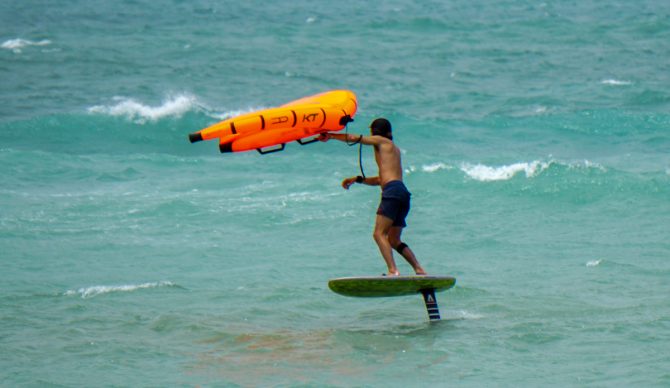
In locations like Maui, where the wind is strong and reliable, small wings are the weapons of choice. Photo: Teague Scanlon//The Inertia
Sizing
As a general rule of thumb for beginners, size up, as it’s better to be overpowered than underpowered. Figure out where you’re going to be learning, and get a wing size that suits the location. For example, 5m is often a good beginner size around the Bay Area, but might be too small somewhere with lighter wind. Or too big for somewhere like Maui. When in doubt, ask around.
Quiver-Building
As you start to build your quiver of wings for windier and lighter days, you’ll notice it’s most common for wingers to build their quivers in one-meter increments. Three meters, 4m, 5m, for example. While that’s not a hard and fast rule, it certainly helps make sure you have all your bases covered without too much overlap.
Handles
Which handles are best for beginners? Good question. Honestly, you can’t go wrong with any of the different handle options, but it’s worth noting that those coming from a windsports background will likely find the boom handle to provide the most intuitive and natural crossover to winging. Those coming into the sport completely fresh may benefit from soft handles for their simplicity and decreased risk of injury should they, say, come within close proximity to your face.
Editor’s Note: Need a board to go with that wing? Check out The Best Wing Foil Boards. If you’re interested in purchasing it all together as a package, here’s our article on The Best Wing Foil Packages. For more foil gear reviews and features on The Inertia, click here.




